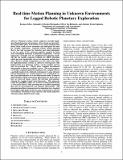Real-time Motion Planning in Unknown Environments for Legged Robotic Planetary Exploration
Author(s)
Albee, Keenan Eugene Sumner; Cabrales Hernandez, Alejandro; Jia-Richards, Oliver; Terán Espinoza, Antonio
DownloadAeroconf2020_Planning.pdf (5.569Mb)
Open Access Policy
Open Access Policy
Creative Commons Attribution-Noncommercial-Share Alike
Terms of use
Metadata
Show full item recordAbstract
Planetary surface robotic explorers currently implement limited amounts of autonomy, often relying on rigorously-developed offline plans. If deviation occurs, long communication delays often result in rover downtime and subsequent lost time for scientific exploration. Onboard robotic motion planning that is fast and accounts for obstacles and robot kinematics is one key piece of the autonomy pipeline required to bring more meaningful autonomy to planetary exploration. Current approaches normally rely on sampling-based planning methods like the rapidly exploring random tree (RRT) algorithm which has had considerable success for kinematic motion planning. However, global computation over the entire state space for high-dimensional systems in cluttered environments-like legged robots on a planetary surface-can be complex and too slow for practical use. What's more, complete environment information is often not available a priori. This work proposes a real-time combined global-local planner for a legged robot in a partially unobserved, cluttered environment. Large obstacles known beforehand (e.g., orbital imagery) are accounted for using a fast global planner on a low-dimensional model. Unknown small obstacles which restrict foot placements are dealt with as they are observed using a slower but real-time local planner, obeying the complex legged robot kinematics. This approach, called SweepingRRT, makes use of observed information locally as it becomes known, while providing the fast global replanning that may be necessitated by new obstacle observations. The planning algorithm is demonstrated in simulation for a standard four-legged, eight-jointed robot in some demonstrative obstacle environments consisting of large (known) and small (unknown) obstacles using a limited sensor range.
Date issued
2020-08Department
Massachusetts Institute of Technology. Department of Aeronautics and AstronauticsJournal
2020 IEEE Aerospace Conference
Publisher
Institute of Electrical and Electronics Engineers (IEEE)
Citation
Albee, Keenan et al. "Real-time Motion Planning in Unknown Environments for Legged Robotic Planetary Exploration." 2020 IEEE Aerospace Conference, March 2020, Big Sky, Montana, Institute of Electrical and Electronics Engineers, August 2020. © 2020 IEEE
Version: Author's final manuscript
ISBN
9781728127347